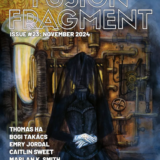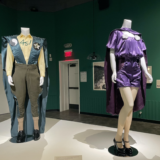Blame it on Boskone. Blaming the long-established Boston science fiction convention with its superb art show absolves Russ Handelman and me for turning us into art collectors. Before Boskone, I had been picking up the occasional spacescape – formally called an “astronomical”– and hanging them in my office at Moody’s Investors Service in downtown Manhattan. One day, I found half the IT staff admiring my wall art and seemingly waiting for wine and cheese to be served.
And then, came the fatal Boskone. Jack Gaughan’s widow was selling a number of her husband’s cover sketches at eminently affordable prices. I had never dreamed I could own a Gaughan, and I dawdled. Just as the Wall of art show staff in turquoise tee shirts marched through the art show to close it, I turned to one of the New England Science Fiction Assocation (NESFA) fans and said, “Please, do you mind if I outbid you on this one?” I pointed to a brightly designed, semi-abstract of a futuristic scientist at a weird control panel. “I need it for my…oh damn.”
The word I choked on was “collection.”
In an odd coincidence, Russell Handelman also started collecting at Boskone. His early loot included two Rick Sternbach paintings and a Kelly Freas sketch.
As partners, Russ and I have inflicted a growing collection of fantasy and SF art onto our innocent suburban home. We come by it naturally. Russ’s paternal grandmother was a potter, a silversmith, and a painter in oils and watercolors. My aunt and uncle were WPA artists whose works hang in places like the Metropolitan Museum of Fine Arts, the Whitney, and the Vatican.
Russ’s grandmother took him on regular visits to the Guggenheim and the Metropolitan Museum of Art, and providing him and his siblings with art supplies. At age six or so, I went to Ohio’s Butler Museum of American Art for lessons that began with charcoal and pastel and moved onto the complexities of water colors and oils. During art class, I learned two things: to get beyond the reverential, it’s-good-for-you approach to art; and how to see, know what you’re seeing, and appreciate quality.
Our ambition went back years. I realized fantasy and science fiction cover art had evolved from Mickey Spillane macho in bubble helmets to the equivalent of Royal Academy exhibitions. For me, this realization gelled at my first Worldcon, Noreascon II in 1980.
Although the price of completed art was still beyond me, concept sketches for cover art – especially for my cover art – were in the ballpark. I began buying sketches and prelims, with a couple prints. Sketches let me see artists’ techniques, while the prelims reveal their color values.
At one Lunacon, I realized that I was in this business for good – and that other people knew it. Bob Eggleton was exhibiting a painting of the volcanoes of Io. I bid on it. One of the turquoise tee shirt art-show crowd came up and told me, “You know, our son keeps saying ‘bid an extra dollar on that and win!’” The art-show specialist asked, “Do you really love the painting? Will you give it a good home?” I assured her that the painting would be cherished and prominently displayed. It’s in the breakfast room with the other astronomicals.
You too can addict yourself to art. If you’re interested in buying what is now grandly termed “imaginative realism,” Russ and I have some pointers that may help enable you.
Know What You Love and Can Live With
That’s “love,” not “like.” I grew up with representational art and I still prefer it. I love alien landscapes. I prefer artists who work in oils, but acrylics, water-colors, and pencil sketches are just fine. So are well-done electronics – but not AI. Because my very early training as a child included sitting on someone’s lap and being shown Rembrandt’s light sources or Rubens’s skin tones, I look for technique. And I don’t want monsters over the sink in the bathroom or facing a bed to scare me in the middle of the night.
How do Russell and I know that a painting must come home with us? If either one of us runs down the hall demanding, “look at this!” we probably have found lawful prey. For example, Russell brought me over to see a work by Sarah Finnegan of Texas. While I am addicted to representational art, this surreal landscape, or mindscape, or whatever scape it is, with its white light at the top of a tower, fascinated me too. It’s in the Den
At yet another Boskone, my editor and I were looking for a cover artist for my book Second Chances, a retelling of Lord Jim. Dave Seeley’s weathered space backgrounds and ships and his hardened spacers had the tone I wanted. The painting he created, in the deep blues and blacks of outer space, is a study in high-tech circles. A window reveals a complex round ship with tendrils leading to other vessels, while in the foreground, a circle of angry crewmembers attack my protagonist. Although the painting is violent, it contains a poignant surprise. If you look closely enough at “Jim’s” face, you see the tear running down his cheek at how he has ruined his life.
Recently, we encountered the artist, teacher, and gamer Jon Sideriadis. His work combines illuminations taken from his Greek heritage with with complex backgrounds and a dominant color landscape of gold, bronze, white, and black. Two of the small ones have come home with us and reside next to a collection of minerals and a pre-Columbian weaving.

As we collected, we started to attend gallery shows, such as Illuxcon, an annual gathering of artists, students, and collectors held each year at the Goggleworks art space in Reading, Pennsylvania. At last year’s Illuxcon, a painting by Donato Giancola stopped us in our tracks. “Frodo’s Inheritance” shows Bilbo writing while holding the One Ring. Its circular shadow, the circle of Bilbo’s arms as he writes, even the round inkwell turn the images in on themselves. The painting’s colors are saturated with the deep green characteristic of the Shore, plus the gold of the One Ring, which is picked up in the stripes on Bilbo’s shirt sleeve and cufflinks. We all were thrilled when the Tolkien Society named it the best Tolkien-inspired painting for 2024. It’s in the living room.

At another Boskone, some of Bob Eggleton’s art stopped us cold: the cover for Jack Dann’s latest collection Islands of Time (Cemetery Dance). The Dann cover is dominated by intense blues.
Size Matters
David Hoffrichter has done three paintings of the hobbits who have been trapped in the Barrow Downs and now lie in coma as the resident barrow wight inches toward them with a sword. Even if the largest version weren’t way beyond our budget, we realized we couldn’t live with an immense radioactive green barrow, conked-out hobbits, and that barrow wight’s hand creeping toward them. Even the medium-sized one unnerved us. But the smallest one was Just Right. It now resides on the wall of our bar room alongside dragons, some Theresa Mathers gemstone art, and a painting of Asgard and the Bifrost Bridge that I acquired at a Seattle production of the Ring Cycle.
Know What You’re Looking At
As our collection grows, we’ve expanded our sources from science fiction art shows to dealers, exhibitions, books, catalogues, and studios. We learn creative techniques and traditions. For example, Caravaggio’s influence informs Donato Giancola’s work. The surrealists, especially Italian painter Giorgio de Chirico, help explain – to us at least – what Michael Whalen’s been up to the past few years. Photographs from the Hubble Telescope confirm me in my belief that Chesley Bonestell is a god. For reference, check the books and spacescapes of Ron Miller, artist, writer, and formerly Art Director for the National Air And Space Museum’s Albert Einstein Planetarium.

Don’t Dicker or Dither
A newbie art collector who starts with “I don’t know much about art, but I know what I like” is off to a great start. We have to love the art we take home. We don’t view it as an investment, but as an expression for our passion for the craft of working artists.
Love what you see. It’s okay not to want monsters in the bathroom.
Don’t fuss or try to dicker. The important element of that rule is in the first four letters of the verb dicker, as in: don’t be one. Remember: artists don’t paint “for the exposure.” They paint because they can’t not paint. They also paint to pay the bills. So, artists know what sort of price they need to set. Just because I personally cannot afford something doesn’t mean I have a right to whine about it. I should add, however, that if you’re polite, artists and dealers can be courteous and help work out payment plans. That is, of course, a personal courtesy.
What’s more, if you dither or try to talk yourself into something (as opposed to rationalizing an “I must be out of my mind” type purchase), move on. You’ll find plenty of things you love. Besides, someone else may snap it up.
Find a Fine Framer
When I lived in Forest Hills, New York, I worked for 30 years with Art World, which also sold cartoon cels. When I joined Russ in Connecticut, we found a new framer, River Road Galleries, now Frame and Save in Norwalk.
Our tastes in frames have evolved from good-taste plain gold frames and all-purpose black to customized frames that involve mats, double mats, interior frames, and various colors, textures, and styles that complement individual works. Note to the wise: if you’ve got etchings, sketches, or water-colors, consider an upgrade to museum-quality glass and do not hang them in the bathroom.
Make Your Home Art-Friendly
It drives me crazier than usual when people in possession of a perfectly good blank wall lose their nerve and nail up only a timid watercolor or reproduction of a sailboat, and leave it at that. We do have pictures of sailboats: a Viking ship woodblock print Russ’s grandmother carved almost to a century ago, another Viking sketch by Bob Eggleton, and a huge Gary Lippincott watercolor of a sailboat that looks as if it’s leaving the Grey Havens. So be brave. Experiment. Have fun with your art.
When a new piece comes home, we carry it from wall to wall so it can tell you where it might be happy and with what other pieces currently up on the walls. It’s fine to hang paintings in a procession along the walls. Or, you can hang them salon fashion, arrayed in in emotional, color, and thematic groupings. The dragons go in one place. The seascapes go in another. The astronomicals have found a home in the breakfast room.
Join Your Art Community
Because we live in New England, we know our local and regional conventions. Worldcons and Boskones on the East Coast are known for good art shows. I’m told Dragoncon’s art show is excellent. And then there’s Illuxcon. Founded in 2008 by Patrick and Jeanne Wilshire and based now in Reading, Pennsylvania, it occupies the Goggleworks, a nineteenth-century factory converted into a three-floor art and performance space. We find online dealers and galleries and even eBay.
As Russ and I meet more artists, we try to give back. At the late lamented Lunacon, I would do docents’ tours. When it came time to pay for the art, the people who ran the convention would often point me out to people making their first purchases with the advice “See her? Do what she does!” or “ask her to help you.”
Because Russell still works in the financial services industry and I spent many years in financial marketing, we speak about financial strategies for creative professionals. Topics include running themselves like a business, assembling the lawyers, accountants, and dealer to back you up, and establishing a creative legacy so that, when artists go to that great big museum in the sky, their art has a home other than goodwill or the nearest dumpster. (It happens.)
Do we have a wish list? Sure. A Virgil Finlay drawing. A surrealistic Michael Whalen. And heaven help us, a Chesley Bonestell planetary landscape. Even if those acquisitions are not going to happen, we don’t care. We’re delighted with what we have and happy to share this journey from collector to “help! we’re running out of wall space” with you and with guests who enter our home and demand to see the “new art.”
See you in the art show!
***

Susan Shwartz has just joined Amazing Stories as a contributor. This is her first article for the website:
After wandering for forty years in the desert of financial services marketing, Susan Shwartz returned to her first love, writing fantasy and science fiction. A five-time nominee for the Nebula, a two-time nominee for the Hugo, with nominations for the World Fantasy Award, the Philip K. Dick, and the Edgar, Susan has published around thirty books, including anthologies, science fiction, historical fantasy, and STAR TREK. Susan has also published about 100 short stories, novelettes and novellas and published nonfiction in THE NEW YORK TIMES, VOGUE, THE WASHINGTON POST, and ANALOG. About four stories are scheduled for release in the next year or so on subjects as diverse as the Soviet Space Program, Anna Comnena, and a two-state solution to climbing Mount Everest. She holds a Ph.D. in English (medieval) from Harvard University, for which she earned 100 percent of her expenses. She now collects SF art and loves the opera, the theatre, and travel. She and her partner live in exurban Connecticut among the deer, the rabbits, and the very occasional bobcat.
Susan Shwartz collects art with her partner Russell Handlemann: Russell Handelman, a financial advisor, is a collector of art and books, a writer of articles and, sometimes, fiction. He enjoys travel, opera, reading, and amassing a variety of objects that he considers fascinating. The art and the books compete for space with various collections. He lives in a house on a rock slab in semi-rural Connecticut with his partner Susan Shwartz. Russell earned his B.A. in history from Yale University and his M.B.A. from the Tuck School of Business at Dartmouth College.
Our Featured image is from the website Artgalleryofhamilton.com and accompanies the article
On Collecting Art: The Creation and Value of a Personal Art Collection











Ooh, all this sounds like good advice.
I bought some original artwork at my first convention (LaCon, 1972), plus took some photos of art (with permission of the artist and of that convention’s art show; not something likely to happen today); and at the other end of my timeline I spent a LOT of my non-volunteering time at Chicon 8 looking at the art show and special art displays, and recently had the pleasure and privilege of being shown around the walls of Joe Siclari and Edie Stern’s house (the walls themselves being largely not visible).
All of which has reminded me how I haven’t done that well in actual collecting (or even accumulating) myself, and how I’m horribly behind in displaying what I have (I’m a photographer myself, so my own work competes for space, too).
I can perhaps make some progress. But more important, some of you out there can be motivated to acquire works you love, and display them where you and your friends can appreciate them properly!